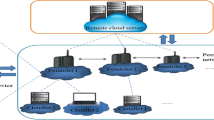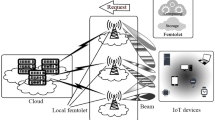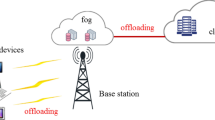Abstract
Power and delay aware cloud service provisioning to mobile devices has become a promising domain today. This paper proposes and implements a cooperative offloading approach for indoor mobile cloud network. In the proposed work mobile devices register under femtolet which is a home base station with computation and data storage facilities. The resources of the mobile devices are collaborated in such a way that different mobile devices can execute different types of computations based on cooperative federation. The proposed offloading scheme is referred as cooperative code offloading in femtolet-based fog network. If none of the mobile device can execute the requested computation, then femtolet executes the computation. Use of femtolet provides the mobile devices voice call service as well as cloud service access. Femtolet is used as the fog device in our approach. The proposed model is simulated using Qualnet version 7. The simulation results demonstrate that the proposed scheme minimizes the energy by 15% and average delay up to 12% approximately than the existing scheme. Hence, the proposed model is referred as a low power offloading approach.















Similar content being viewed by others
Explore related subjects
Discover the latest articles and news from researchers in related subjects, suggested using machine learning.References
Mukherjee A, De D (2016) Femtolet: a novel fifth generation network device for green mobile cloud computing. Simul Model Pract Theory 62:68–87
Mukherjee A, Bhattacherjee S, Pal S, De D (2013) Femtocell based green power consumption methods for mobile network. Comput Netw 57:162–178
Satyanarayanan M, Bahl P, Caceres R, Davies N (2009) The case for VM-based cloudlets in mobile computing. Pervasive Comput 8:14–23
Fernando N, Loke SW, Rahayu W (2013) Mobile cloud computing: a survey. Future Gener Comput Syst 29:84–106
Verbelen T, Pieter S, Filip D T, Bart D (2012) Cloudlets: bringing the cloud to the mobile user. In: Proceedings of the Third ACM Workshop on Mobile Cloud Computing and Services, ACM, pp 29–36
Gai K et al (2016) Dynamic energy-aware cloudlet-based mobile cloud computing model for green computing. J Netw Comput Appl 59:46–54
Mukherjee A, De D, Roy DG (2016) A power and latency aware cloudlet selection strategy for multi-cloudlet environment. IEEE Trans Cloud Comput 99:1–1
Roy DG, De D, Mukherjee A, Buyya R (2016) Application-aware cloudlet selection for computation offloading in multi-cloudlet environment. J Supercomput 73:1672–1690
Song J, Cui Y, Li M, Qiu J, Buyya R (2014) Energy-traffic tradeoff cooperative offloading for mobile cloud computing. In: IEEE 22nd International Symposium of Quality of Service, pp. 284–289
TawalbehL A, JararwehY DosariF (2015) Large scale cloudlets deployment for efficient mobile cloud computing. J Netw 10:70–76
MahmudR, BuyyaR (2017) Fog computing: a taxonomy, survey and future directions. In: DiMartino B, Li K, Yang L, Esposito A (eds) Internet of everything: algorithms, methodologies, technologies and perspectives. Springer, Singapore, pp. 103–130. ISBN 978-981-10-5860-8
Jalali F et al (2016) Fog computing may help to save energy in cloud computing. IEEE J Sel Areas Commun 34:1728–1739
Ahmad M, Amin MB, Hussain S, Kang BH, Cheong T, Lee S (2016) Health fog: a novel framework for health and wellness applications. J Supercomput 72:3677–3695
Shuja J, Mustafa S, Ahmad RW, Madani SA, Gani A, Khan MK (2017) Analysis of vector code offloading framework in heterogeneous cloud and edge architectures. IEEE Access 5:24542–24554
Durao F, Carvalho JFS, Fonseka A, Garcia VC (2014) A systematic review on cloud computing. J Supercomput 68:1321–1346
Wang X, Wang J, Wang X, Chen X (2017) Energy and delay tradeoff for application offloading in mobile cloud computing. IEEE Syst J 11:858–867
Singh S, Chana I (2015) QRSF: QoS-aware resource scheduling framework in cloud computing. J Supercomput 71:241–292
Chunlin L, LaYuan L (2015) Cost and energy aware service provisioning for mobile client in cloud computing environment. J Supercomput 71:1196–1223
Shiraz M, Ahmed E, Gani A, Han Q (2014) Investigation on runtime partitioning of elastic mobile applications for mobile cloud computing. J Supercomput 67:84–103
Shuja J, Gani A, ur Rehman MH, Ahmed E, Madani SA, Khan MK, Ko K (2016) Towards native code offloading based MCC frameworks for multimedia applications: a survey. J Netw Comput Appl 75:335–354
Chen X, Chen S, Zeng X, Zheng X, Zhang Y, Rong C (2017) Framework for context-aware computation offloading in mobile cloud computing. J Cloud Comput 6:1
Ahmed E, Rehmani MH (2016) Mobile edge computing: opportunities, solutions, and challenges. Future Gener Comput Syst 70:59–63
Roman R, Lopez J, Mambo M, Mobile Edge Computing, Fog et al. (2016) A survey and analysis of security threats and challenges, arXiv preprint arXiv:1602.00484
Mao Y, Zhang J, Letaief KB (2016) Dynamic computation offloading for mobile-edge computing with energy harvesting devices. IEEE J Sel Areas Commun 34:3590–3605
Chen X, Jiao L, Li W, Fu X (2016) Efficient multi-user computation offloading for mobile-edge cloud computing. IEEE/ACM Trans Netw 24:2795–2808
Acknowledgements
We are grateful to Department of Science and Technology (DST) project funding SR/FST/ETI-296/2011 and TEQIP III. This work is partially supported by ARC Future Fellowship and Melbourne-Chindia Cloud Computing Research Network.
Author information
Authors and Affiliations
Corresponding author
Rights and permissions
About this article
Cite this article
Mukherjee, A., Deb, P., De, D. et al. C2OF2N: a low power cooperative code offloading method for femtolet-based fog network. J Supercomput 74, 2412–2448 (2018). https://doi.org/10.1007/s11227-018-2269-x
Published:
Issue Date:
DOI: https://doi.org/10.1007/s11227-018-2269-x




